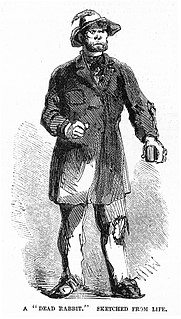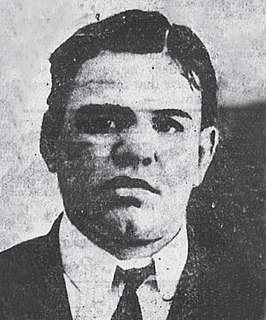
Manhattan's Chinatown is a neighborhood in Lower Manhattan, New York City, bordering the Lower East Side to its east, Little Italy to its north, Civic Center to its south, and Tribeca to its west. With an estimated population of 90,000 to 100,000 people, Chinatown is home to the highest concentration of Chinese people in the Western Hemisphere. Manhattan's Chinatown is also one of the oldest Chinese ethnic enclaves. The Manhattan Chinatown is one of nine Chinatown neighborhoods in New York City, as well as one of twelve in the New York metropolitan area, which contains the largest ethnic Chinese population outside of Asia, comprising an estimated 893,697 uniracial individuals as of 2017.

The Dead Rabbits was the name of an Irish American criminal street gang in Lower Manhattan in the 1850s. The Dead Rabbits were so named after a dead rabbit was thrown into the center of the room during a gang meeting, prompting some members to treat this as an omen, withdraw, and form an independent gang. Their battle symbol was a dead rabbit on a pike. They often clashed with Nativist political groups who viewed Irish Catholics as a threatening and criminal subculture. The Dead Rabbits were given the nicknames the "Mulberry Boys" and the "Mulberry Street Boys" by the New York City Police Department because they were known to have operated along Mulberry Street in the Five Points.

The Gopher Gang was an early 20th-century New York street gang known for its members including Goo Goo Knox, James "Biff" Ellison, and Owney Madden. Based in the Irish neighborhood of Hell's Kitchen, the Gopher Gang grew to control most of Manhattan with their territory covering Fourth to Forty-Second Street and Seventh to Eleventh Avenue.
The Crazy Butch Gang was an American juvenile street gang active in the New York City underworld during the late nineteenth century. Largely active in Manhattan's Lower East Side, the group were widely known as the cities top pickpockets and sneak thieves during the "Gay Nineties" period. An early member of this gang would later become known as a prominent New York gangster Jack Zelig.

The Morello crime family was one of the earliest crime families to be established in the United States and New York City. The Morellos were based in Manhattan's Italian Harlem and eventually gained dominance in the Italian underworld by defeating the rival Neapolitan Camorra of Brooklyn.
William J. "Wild Bill" Lovett was an Irish American gangster in early 20th century New York.

The Whyos or Whyos Gang, a collection of the various post-Civil War street gangs of New York City, was the city's dominant street gang during the mid-late 19th century. The gang controlled most of Manhattan from the late 1860s until the early 1890s, when the Monk Eastman Gang defeated the last of the Whyos. The name came from the gang's cry, which sounded like a bird or owl calling, "Why-oh!"

Mott Street is a narrow but busy thoroughfare that runs in a north–south direction in the New York City borough of Manhattan. It is regarded as Chinatown's unofficial "Main Street". Mott Street runs from Bleecker Street in the north to Chatham Square in the south. It is a one-way street with southbound-running vehicular traffic only.

The Eastman Gang was the last of New York's street gangs which dominated the city's underworld during the late 1890s until the early 1910s. Along with the Five Points Gang under Italian immigrant Paul Kelly, the Eastman gang succeeded the long dominant Whyos as the first non-Irish street gang to gain prominence in the underworld during the 1890s, and marked the beginning of a forty to fifty-year period of heavy Jewish-American influence within organized crime in New York City.
Batavia Street Gang was a New York independent street gang based in the Fourth Ward during the 1890s. Affiliated with the Eastman Gang during the turn of the 20th century, they were rivals of the Cherry Hill Gang throughout the previous decade. During one incident, five members of the gang were arrested for breaking into Seigel's jewelry store in order to purchase costumes for the Sullivan ball at New Irving Hall in an attempt to out do their rivals, who were known to be "dandies", had announced they would be attending in extravagant evening clothes.
Juan Flores was a 19th-century Californio bandit who, with Pancho Daniel, led an outlaw gang known as "las Manillas" and later as the Flores Daniel Gang, throughout Southern California during 1856-1857. Although regarded by historians as a thief and outlaw, Flores was considered among Mexican-Americans as a folk hero akin to Jesse James and who was thought of as a defender against vigilante movements in the years following the American settlement of California and its incorporation into the United States. However, the activities of Flores and other insurrectos such as Salomon Pico and Joaquín Murrieta against American and foreign-born settlers not only created long-lasting suspicion and hostility towards Mexican-Americans but also divided the traditional Spanish class structures of the Californios and the poorer peasants as well.
The Baxter Street Dudes was a New York teenage street gang, consisting of former newsboys and bootblacks, who ran the Grand Duke's Theatre from the basement of a dive bar on Baxter Street during the 1870s. Led by founder Baby-Face Willie, gang members operated the Grand Duke's Theatre and established the venue as their headquarters. Members of the Baxter Street Dudes wrote and performed plays, musicals and variety shows which were enjoyed by other street toughs and slummers throughout the city. The theater house eventually became a popular underworld hangout, from which the gang found financial success.
Captain Isaiah Rynders was an American businessman, sportsman, underworld figure and political organizer for Tammany Hall. Founder of the Empire Club, a powerful political organization in New York during the mid-19th century, his "sluggers" committed voter intimidation and election fraud on behalf of Tammany Hall throughout the 1840s and 1850s before Tammany became an exclusively Irish-dominated institution.
The Rhodes Gang was an American street gang based in New York City at the turn of the 20th century. The group was one of several smaller Hell's Kitchen gangs affiliated with the Gopher Gang, all of whom were almost constantly fighting among each other, among these including The Gorillas and the Parlor Mob. They were known, at times, to briefly put aside their differences when police attempted to interfere in gang fights and authorities found the area impossible to control.

The Patsey Conroy Gang or Patsy Conroys were a group of river pirates active along the New York City waterfront of the old Fourth Ward during the post-American Civil War era. For nearly twenty years the Patsy Conroys dominated the area of Corlears' Hook and were one of the last major waterfront gangs to remain in the district prior to the formation of the George Gastlin's Steamboat Squad of New York City Police Department. The Patsey Conroy Gang abruptly disappeared when their leaders Patsy Conroy, Larry Griffin and Denny Brady were imprisoned in 1874.
Boiled (Biled) Oysters Malloy was the pseudonym of an American saloon keeper, thief and underworld figure in New York City during the mid-to late 19th century. He was especially known in The Bowery where he ran a popular basement bar and underworld hangout, located on Centre Street near the Tombs, known as The Ruins where "three drops of terrible whiskey were sold for a dime". His establishment was one of several owned by popular Bowery characters, most notably Mush Riley, whose dive bar was located just a few doors away from The Ruins. Malloy's nickname was derived from "his love of boiled oysters", and, according to Frank Moss in The American Metropolis from Knickerbocker Days to the Present Time (1897), when his mother commented on his diamonds and fine clothes would respond "Arrah, mother, I've struck it. I'm living on biled oysters."
The Hole-in-the-Wall was a popular saloon and underworld hangout in what is now the South Street Seaport, Manhattan, New York City during the early- to mid-19th century. It has been described as the "most notorious" saloon in New York city during the 19th century. It was one of many dive bars and similar establishments in New York's infamous Fourth Ward, located at the corner of Water and Dover Streets. The saloon was owned by "One Armed" Charley Monell and featured notorious female criminals Kate Flannery and Gallus Mag as bouncers. Both women were employed by Monell as lieutenants in his local criminal organization, which included shanghaiing, and the latter woman supposedly kept a collection of human ears which she had bitten off from unruly customers in bar brawls. She displayed these as trophies on the bar in pickle jars. Sadie the Goat, the later leader of the Charlton Street Gang, was of the many victims who lost her ear in a brawl with Gallus Mag.
Frank Stephenson was an American saloon keeper and underworld figure in New York City during the mid-to late 19th century. He was the owner of The Black and Tan, a popular Bowery basement bar located on Bleecker Street. It was one of the first saloons to cater to African-Americans and was a competitor against neighboring establishments such as Harry Hill's gambling resort and Billy McGlory's Armory Hall among others. He is also credited for opening the city's first and oldest "undisguised" gay bar, The Slide, also on Bleecker Street.
Tom Bray was an American saloon keeper and underworld figure in New York City during the mid-to late 19th century. He was the owner of a downtown Manhattan dive bar, "Tom Bray's", located on Thompson Street, and which served as an underworld hangout for thieves and bank robbers. The saloon, according to author Frank Moss, was known for its violence as "several men were killed there and a number were badly cut and shot" during its forty years in operation.










